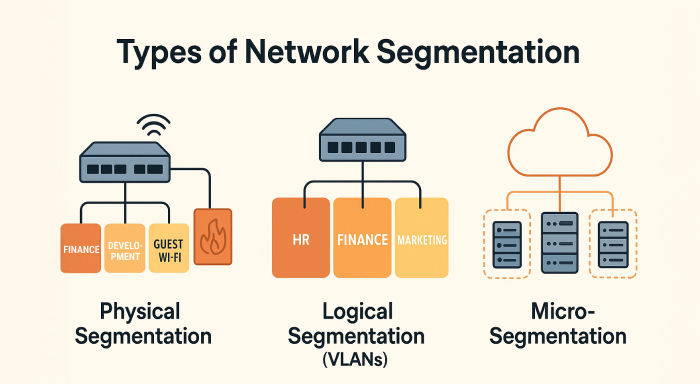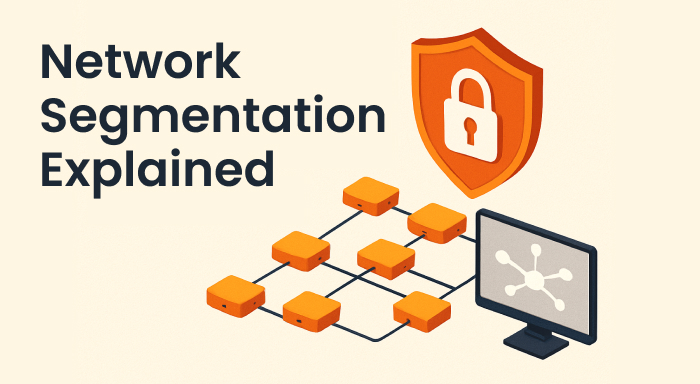In an ever-evolving landscape, cyberthreats are becoming more advanced, frequent, and expensive. The increasing risks of data breaches, insider threats, and ransomware attacks forces businesses to implement security practices.
Although a slight vulnerability can compromise the integrity of the entire network instantly if the problem is overlooked. Network Segmentation is one of the powerful techniques to mitigate these security challenges.
But the questions are: what exactly does it mean and why does it matters for enhanced cybersecurity? This blog will help you know everything about it with expert insights and knowledge from the professionals at Forged It Services.
Understand Network Segmentation
Network segmentation is a robust strategy for splitting a broad network into smaller, independent chunks, called segments, subnetworks, and zones. Each part works as an individual of tiny network with its own characteristics, like security protocols, monitoring policies, and access controls.
Let’s suppose you’re dividing a large office infrastructure into small, secure spaces where every room is equipped with authorized resources and people. Entering a room doesn’t mean you can access other room’s resources. This emphasizes each space is protected and only provides access if an individual truly needs it.
However, segmenting networks into different subnetworks can add an extra layer of security for safeguarding critical points. This makes it difficult for attackers to access your system or exploit your sensitive information.
Different Kinds of Network Segmentation

Businesses can implement network segmentation with numerous ways, including:
- Physical Segmentation:
- Leveraging individual hardware, like routers, firewalls, and switches to create network segments.
- For instance, a large organization might use individual hardware for different domains, like finance department, development team, or guest Wi-Fi access.
- Unlike virtual techniques, efficient and highly secure physical segmentations can be less versatile and more costly.
- Logical Segmentation (VLANs):
- Virtual LANs (VLANs) let businesses divide traffic on the same physical network without additional hardware.
- VLANs are cheap and more flexible, allowing admins to segment network traffic based on function, user role, and department.
- Like, many HR and finance VLANs have robust authentication guidelines, as compared to marketing LANs.
- Micro-Segmentation:
- This software-driven strategy is typically used in data centers or cloud infrastructure. It separates tasks, applications, or isolated servers, offering comprehensive control of which systems can interact with each other.
- Essentially, micro-segmentation is crucial for sophisticated relentless attacks that are performed to move sideways across a network.
How Network Segmentation Enhances Cybersecurity
1. Prevents Cyberattacks Expansion
A single vulnerability can encourage cybercriminals to exploit or penetrate overall network infrastructure. However, implementation segmentation allows users to safeguard their systems against potential threats. This ensures attackers cannot automatically access critical internal systems if they gain access to one segment like guest Wi-Fi network.
For instance, if an employee’s workstation is compromised through infected malware, micro segments help mitigate the expansion of infection to finance or HR departments. Consequently, segmentation confines potential threats, minimizing their overall impact.
2. Safeguard Sensitive Data
With segmentation, businesses can protect their important assets by implementing robust security protocols. This ensures every critical information is safe from unauthorized access, including client details, payment transactions, or intellectual property assets.
Role-driven access across every segment fosters businesses to restrict unauthorized access, allowing only legitimate personnel to access sensitive data. This approach ensures your data is always protected, even if an attacker compromises one area of the network.
3. Streamlines Compliance
Organizations need to adhere to regulatory standards, such as HIPAA, SDPR, and PCI DSS to separate critical data and restrict access strictly. Network segmentation streamlines the compliance requirement by precisely setting boundaries within the overall sensitive systems.
For example, if a healthcare implement segmentation, this helps them segment patient records, payment details, and regulatory needs from open Wi-Fi traffic. More than improving asset security, this helps demonstrate adherence to privacy policy, ultimately minimizing risks of penalties or reputational harm.
4. Improve Visibility and Ongoing Monitoring
Specific, controlled network segments make it simpler to track traffic and identify suspicious activities. Security teams can create foundational traffic patterns for every segment and detect anomalies in real-time.
Suppose a sudden cyberattack integrates malicious device into a system to access finance segment illegitimately. Network segmentation will automatically trigger alert notifications, letting admins take preventive steps before breach escalates. Besides, this also strengthens the efficiency of event management (SIEM), intrusion detection systems (IDS), and security information tools by refining monitoring parameters.
5. Supports Quick Incident Response
In case of cyberthreat, network segmentation restricts suspicious movement in affected areas. This enables security teams to segment damaged subnetworks, evaluate attacks, and resolve issues without stopping the overall systems.
This strategy minimizes downtime and reduces the impact on business workflow. Additionally, it enables forensic teams to detect the attack source and implement proactive improvements. Instead of performing large, transformative changes, such as shutting down all segments or reconfiguring a broad portion of the network.
Ethical Challenges to Consider
Despite the flexibility, effectiveness, robustness of network segmentation, it also comes with various challenges. Including:
- Complexity: Over-segmentation can cause potential challenges in management and may reduce legitimate interaction if not configured correctly.
- Expenses: Physical segmentation is more expensive than virtual LANs, mainly for enterprise networks with a wide range of sites.
- Continuous Maintenance: With the growth of businesses and network configuration changes, segmentation needs to be regularly updated, and continuous monitoring is crucial for ensuring security.
Meanwhile, improving security while maintaining operational efficiency is more crucial than ever before. An ineffectively created segmentation technique can create vulnerabilities, damaged user experience, and potential security gaps.
Conclusion: Importance of Network Segmentation
Network segmentation has become the foundation of state-of-the-art cybersecurity practices. Implementing segmentation for critical infrastructure offers a comprehensive control of access management, prevention of threat expansion, and regulatory compliance adherence. In essence, businesses can drastically minimize the risk of data theft, improve resilience, and take action before things get worse.
Thoughtful implementation of network segmentation is not just as a technical aspect but also becomes a vital part of an overall security framework. This involves smart threat detection, faster incident response, and effective employee training, ensuring the system's effectiveness and competitiveness with the current evolving landscape of cyberattacks.
Leaving your network as a single, open space is like keeping every door open in a building while hoping no one walks in. Segmentation resolves this issue with a series of controlled and tracked subnetworks, mitigating the risk of cybercriminals to exploit the system.
When you implement segmentation with integrated ongoing monitoring, access control standards, and a zero-trust approach, it entirely redefines your infrastructure to a cybersecurity powerhouse.




%201.png)

%201.png)

%201.png)

